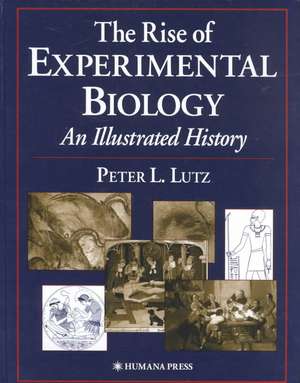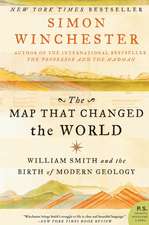The Rise of Experimental Biology: An Illustrated History
Autor Peter L. Lutzen Limba Engleză Hardback – 19 apr 2002
| Toate formatele și edițiile | Preț | Express |
|---|---|---|
| Paperback (1) | 568.43 lei 39-44 zile | |
| Humana Press Inc. – 8 dec 2010 | 568.43 lei 39-44 zile | |
| Hardback (1) | 581.07 lei 39-44 zile | |
| Humana Press Inc. – 19 apr 2002 | 581.07 lei 39-44 zile |
Preț: 581.07 lei
Preț vechi: 726.34 lei
-20% Nou
Puncte Express: 872
Preț estimativ în valută:
111.19€ • 116.33$ • 92.36£
111.19€ • 116.33$ • 92.36£
Carte tipărită la comandă
Livrare economică 31 martie-05 aprilie
Preluare comenzi: 021 569.72.76
Specificații
ISBN-13: 9780896038356
ISBN-10: 0896038351
Pagini: 200
Ilustrații: XIII, 201 p. 109 illus., 9 illus. in color.
Dimensiuni: 210 x 279 x 20 mm
Greutate: 0.75 kg
Ediția:2002
Editura: Humana Press Inc.
Colecția Humana
Locul publicării:Totowa, NJ, United States
ISBN-10: 0896038351
Pagini: 200
Ilustrații: XIII, 201 p. 109 illus., 9 illus. in color.
Dimensiuni: 210 x 279 x 20 mm
Greutate: 0.75 kg
Ediția:2002
Editura: Humana Press Inc.
Colecția Humana
Locul publicării:Totowa, NJ, United States
Public țintă
ResearchCuprins
1. Introduction: Science Is Improbable.- 2. The Beginnings.- Myth and Magic.- Mesopotamia.- Egypt.- 3. Early Greek Science.- The Milesians.- The Post-Milesians.- The Soul.- Summary.- 4. The Age of Plato and Aristotle.- Plato and Theory.- Aristotle and Observation.- 5. The Alexandrian Period: The Age of the Experiment and the Textbook.- 6. The Roman Period.- Celsus.- Pliny.- Galen.- 7. The Middle Ages.- 8. Islamic Science.- 9. Scholasticism and Science.- 10. Renaissance I: The Birth of Science.- 11. Renaissance II: The Birth of Experimental Biology.- 12. The New Physiology.- Iatrochemistry.- Iatrophysics.- 13. New Technology, New Physiology.- The New World of the Very Small: The Microscope.- Vital Air: The Development of Pumps and Early Theories of Respiration.- The Thermometer and Body Heat.- 14. Reaction and Opposition.- 15. The Enlightenment and Rational Biology.- Rational Biology.- The Emergence of Physiology.- 16. Transition to the Nineteenth Century: Popular Science, Eccentric Science, and Romantic Physiology.- Hunter and Spallanzani: The Last Great All-Rounders.- The Science Museum: Collecting and Displaying.- Romantic Physiology.- 17. Consolidation of Experimental Biology.- Respiration.- Metabolic Chemistry.- Internal Secretions.- Renal Physiology.- Digestion.- Benefits.- New Fields.- 18. Evolution and Physiology.- 19. Physiology Abused.- Gullibility.- Reckless Intervention.- Evolutionary Genetics and Social Repression.- 20. Today.- What is Science?.- Biology Today.- References.- List of Illustrations.- Biography.
Recenzii
Foreword by Robert Boutilier, PhD, Cambridge University, Cambridge, UK
"This is a book that will entertain as well as inform a broad audience, from natural philosophers to experimental biologists to medical scientists...[It] is a celebration of the intellectual evolution of the science of physiology and medicine as well as being a socially conscious reminder of our privileged place in nature. I commend it to you."
-Bob Boutilier, PhD, Cambridge University
"a highly readable and attractive book that is both informative and entertaining. . .In relatively short, pithy, and generously-illustrated chapters, Lutz tells the story of biological discovery from the prehistoric cave painters and their intriguing and naturalistic portrayals of their prey animals, on through the major contributions by the Mesopotamians, the Egyptians, the Greeks, the Romans, the Arab world, and the European periods from the Middle Ages, to the Renaissance, the Enlightenment, and into the modern era. His account makes clear that the growth of biological knowledge was by no means a smooth progression, but rather a highly erratic one that advanced rapidly at certain times and then stagnated or regressed as societies favored orthodoxy or mysticism over curiosity and rationality. The book does an excellent job in tracing the development of ideas, and introducing us to the remarkable individuals who were the scientific giants of their times. An appropriate addition on the office bookshelf or for the home library, it is a volume that can be savored in small chapter-sized bites or devoured by an avid reader in a single sitting. Some may simply wish to leaf through and enjoy the illustrations. However it is read, it is a most valuable contribution and both an accessible and timely introduction to the history of biology."-Journal for Experimental BiologyR>
"This is a book that will entertain as well as inform a broad audience, from natural philosophers to experimental biologists to medical scientists...[It] is a celebration of the intellectual evolution of the science of physiology and medicine as well as being a socially conscious reminder of our privileged place in nature. I commend it to you."
-Bob Boutilier, PhD, Cambridge University
"a highly readable and attractive book that is both informative and entertaining. . .In relatively short, pithy, and generously-illustrated chapters, Lutz tells the story of biological discovery from the prehistoric cave painters and their intriguing and naturalistic portrayals of their prey animals, on through the major contributions by the Mesopotamians, the Egyptians, the Greeks, the Romans, the Arab world, and the European periods from the Middle Ages, to the Renaissance, the Enlightenment, and into the modern era. His account makes clear that the growth of biological knowledge was by no means a smooth progression, but rather a highly erratic one that advanced rapidly at certain times and then stagnated or regressed as societies favored orthodoxy or mysticism over curiosity and rationality. The book does an excellent job in tracing the development of ideas, and introducing us to the remarkable individuals who were the scientific giants of their times. An appropriate addition on the office bookshelf or for the home library, it is a volume that can be savored in small chapter-sized bites or devoured by an avid reader in a single sitting. Some may simply wish to leaf through and enjoy the illustrations. However it is read, it is a most valuable contribution and both an accessible and timely introduction to the history of biology."-Journal for Experimental BiologyR>
Textul de pe ultima copertă
For more than three thousand years our physiological and medical knowledge has developed from the simple reading of entrails to the computerized decoding of the human genome. In The Rise of Experimental Biology: An Illustrated History, Peter Lutz, PhD, brilliantly traverses the major milestones along the evolutionary path of biomedicine from earliest recorded times to the dawn of the 20th century. With an engaging narrative that will have you turning "just one more page" well into the night, this book revealingly demonstrates just how the modern scientific method has been shaped by the past. Along the way the reader is treated to some delightfully entertaining anecdotes and a treasure trove of illustrations that chronicle the tortuous history of biomedical developments, ranging from the bizarre and amusing to the downright macabre. The reader will also be introduced to the major ideas shaping contemporary experimental biology, as well as their social context, and also learn how advances in their understanding have occasionally been improperly used to satisfy momentary social or political needs.
Accessibly written and richly pictorial, The Rise of Experimental Biology: An Illustrated History will entertain as well as inform a broad audience of not only experimental biologists, medical scientists, and natural philosophers, but also everyone interested in history and medicine today.
Accessibly written and richly pictorial, The Rise of Experimental Biology: An Illustrated History will entertain as well as inform a broad audience of not only experimental biologists, medical scientists, and natural philosophers, but also everyone interested in history and medicine today.
Caracteristici
Includes supplementary material: sn.pub/extras











